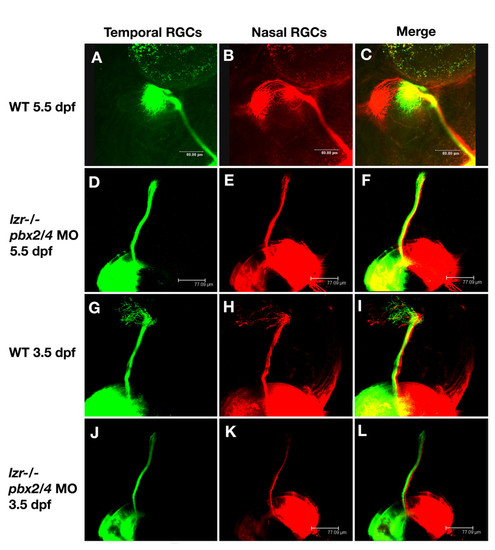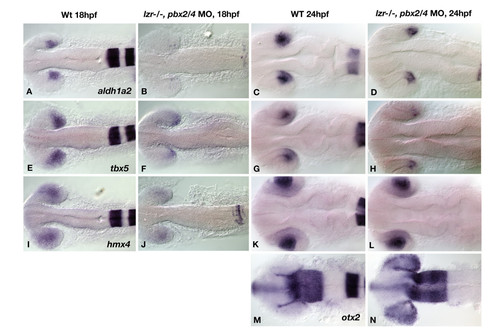- Title
-
Pbx homeodomain proteins pattern both the zebrafish retina and tectum
- Authors
- French, C.R., Erickson, T., Callander, D., Berry, K.M., Koss, R., Hagey, D.W., Stout, J., Wuennenberg-Stapleton, K., Ngai, J., Moens, C.B., and Waskiewicz, A.J.
- Source
- Full text @ BMC Dev. Biol.
|
The laminar structure of pbx2/4 null eyes is normal after 5 days of development. All laminar layers are present and in both wild type (A and B) and, and lzr mutants injected with pbx2/4 morpholinos (D and E). We note a consistent decrease in eye size in pbx2/4 null embryos, but the proportion of eye area occupied by the retinal pigmented epithelium in morphants is significantly increased (F verses C). The relative position of the optic nerve is similar in both wild type and morphant embryos. The retinal photoreceptor layer is absent in the ventral domain of the eye in lzr mutants injected with pbx2/4 morpholinos (I) when compared to wildtype (G) and is disorganized (compare H, wildtype, with J, lzr mutants injected with pbx2/4 morpholinos). Photoreceptor labeling was accomplished using the zpr-1 monoclonal antibody. PHENOTYPE:
|
|
pbx2/4 null embryos exhibit RGC axonal outgrowth defects. In wild type embryos at 5.5 dpf, temporal RGC axons map to the anterior optic tectum (A) and (C), while nasal RGC axons map to the posterior region of the optic tectum (B) and (C). This is also seen at 3.5 dpf (G-I) although the connections on the tectum are more diffuse. In lzr-/- mutants injected with pbx2/4 morpholinos, both posterior and anterior RGC axons fail to map onto the optic tectum at both 3.5 dpf (J-L) and 5.5 dpf (D-F). PHENOTYPE:
|
|
Gene expression analysis via in situ hybridization shows altered expression of Pbx dependent transcripts in pbx2/4 null embryos. The expression of aldh1a2, tbx5, and hmx4 is reduced in pbx2/4 null embryos (B, F, and J), when compared to wild type (A, E, and I) at 18 hpf. At 24 hpf, aldh1a2 and tbx5 show reduced expression in pbx2/4 null embryos (D and H) when compared to wildtype (C and G), while the expression of hmx4 is unaffected (K and L). The expression of otx2 is limited to the RPE at the periphery of the eye in wild type embryos at 24 hpf (M), and is expanded to the posterior retina in pbx2/4 null embryos (N). All embryos were hybridized with the probe indicated, as well as egr2b, as an indicator of the level of Pbx function. EXPRESSION / LABELING:
PHENOTYPE:
|
|
meis1.1 is required for expression of aldh1a2. The expression of aldh1a2 is reduced in meis1.1 morphants (B) when compared to wild type (A) at 24 hpf. As a control for morpholinos specificity, injection of meis 1.1 mRNA rescues this phenotype (compare B and C). All embryos were also hybridized with hoxa2b as well as aldh1a2. |
|
The expression of rx2, rx3, and atoh7 is aberrant in pbx2/4 null embryos. The expression of rx3, the earliest known eye field marker is unaffected at the tailbud and 4 somite stage (A-D) but is increased in expression at the 10 somite stage (H) when compared to wildtype (G). The expression of rx2 is reduced at both the 4 and 10 somite stage in pbx2/4 null embryos (F and J), when compared to wildtype (E and I). No expression of rx2 is observed at the tailbud stage. The expression of atoh7 was analyzed as a marker of differentiating retinal ganglion cells. In wild type embryos, expression begins in the ventral nasal domain of the retina at about 31 hpf (K). Expression proceeds in a wave-like fashion to include the dorsal retina by 36 hpf (L), and has filled the entire retina by 41 hpf (M). In pbx2/4 null embryos, expression is initiated correctly at 31 hpf (N). Expression proceeds in a wave-like fashion but is excluded from the dorsal domain of the retina at both 36 hpf (O) and 41 hpf (P). EXPRESSION / LABELING:
PHENOTYPE:
|
|
Aberrant tectal patterning is observed in pbx2/4 null embryos. efna2 expression includes the posterior forebrain, the tectum, and the anterior hindbrain in wild type embryos (A), and is reduced in pbx2/4 null embryos (B) at 24 hpf. The expression of both nat10 and fabp7a includes both the eye and tectum in wild type embryos (C) and (E), and is almost completely absent in both regions in pbx2/4 null embryos (D and F). otx2 is expressed in the optic tectum at 48 hpf, specifically toward the periphery of the tectum with lower levels observed immediately adjacent to the eye (G). In pbx2/4 null embryos, there is a distinct change in expression domain in which the highest levels of expression are observed immediately adjacent to the eye (H). The gradient of efnA5a expression, which decreases toward the anterior (I), is attenuated at 48 hpf in pbx2/4 null embryos (J). The acetylated tubulin antibody marks the axons of the optic tectum at 3 dpf (K), which is smaller and disorganized in pbx2/4 null embryos (L). EXPRESSION / LABELING:
PHENOTYPE:
|
|
gdf6a is genetically downstream of pbx2/4 and is necessary for expression of genes in the dorsal/temporal retina. Expression of gdf6a is strongly reduced in pbx2/4 null embryos (B), when compared with wildtype (A) at 24 hpf. Knockdown of gdf6a results in a loss of aldh1a2 and tbx5 expression (D and F) when compared with wildtype (C and E). pbx2/4 null embryos were also hybridized with egr2b as well as gdf6a, as a marker of pbx function. |







